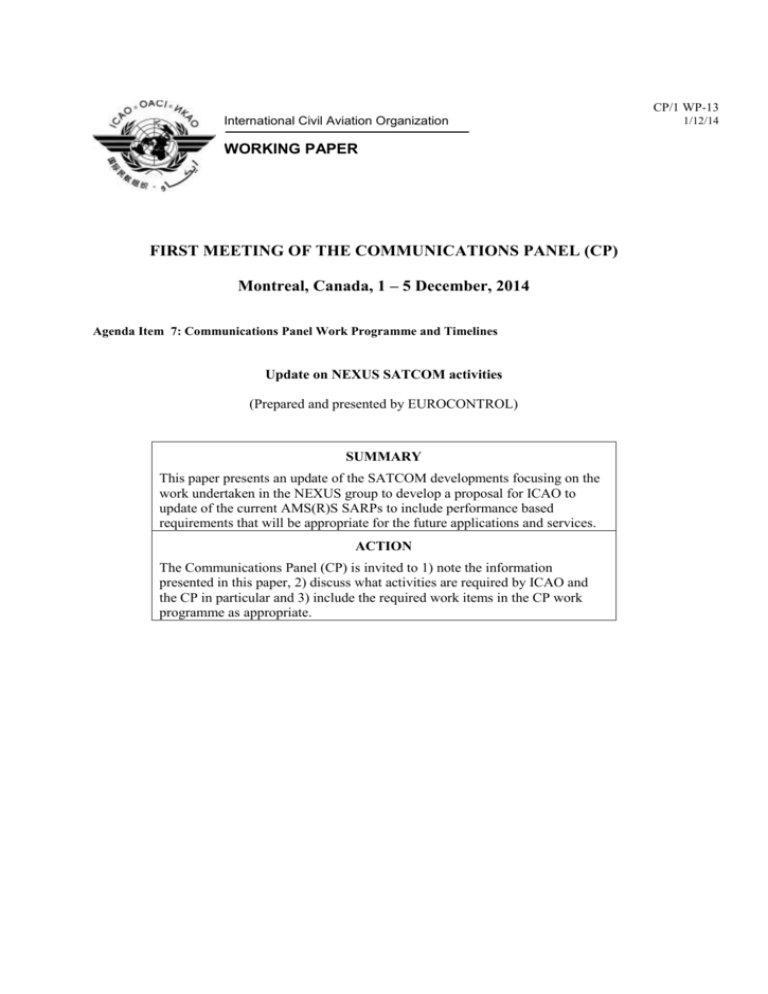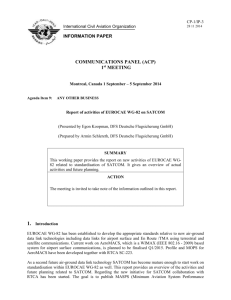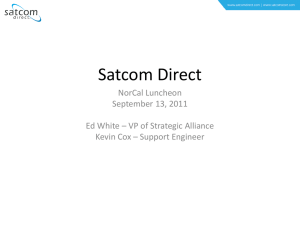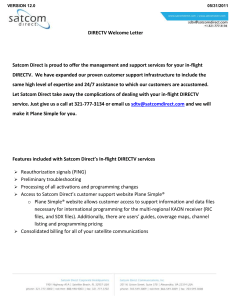Update on NEXUS SATCOM activities
advertisement

CP/1 WP-13 International Civil Aviation Organization WORKING PAPER FIRST MEETING OF THE COMMUNICATIONS PANEL (CP) Montreal, Canada, 1 – 5 December, 2014 Agenda Item 7: Communications Panel Work Programme and Timelines Update on NEXUS SATCOM activities (Prepared and presented by EUROCONTROL) SUMMARY This paper presents an update of the SATCOM developments focusing on the work undertaken in the NEXUS group to develop a proposal for ICAO to update of the current AMS(R)S SARPs to include performance based requirements that will be appropriate for the future applications and services. ACTION The Communications Panel (CP) is invited to 1) note the information presented in this paper, 2) discuss what activities are required by ICAO and the CP in particular and 3) include the required work items in the CP work programme as appropriate. 1/12/14 CP1 WP/13 1. -2- INTRODUCTION 1.1 SATCOM communications is a key component of the Future Aeronautical Communications Infrastructure (FCI). SATCOM, together with the terrestrial systems, is a critical enabler of the future concepts developed in the context of the SESAR, NextGEN and CARATS ATM modernisation programmes. 1.2 ACP WGW, in its 2nd meeting in 2008, discussed the FCI aspects and in particular for the satellite communications developed the following recommendation: R3: Recognising that satellite communications remain the prime candidate to support oceanic and remote environments and that the considered future satellite systems may also be able to support continental environments possibly complementing terrestrial systems, monitor and support developments that will lead to globally available ATS satellite communications. 1.3 In line with the ICAO/ACP and the EUROCONTROL-FAA Action Plan 17 recommendations for the future satellite communications, the EUROCONTROL NexSAT Group (http://www.eurocontrol.int/nexsat/) addressed the need to update the existing AMS(R)S SARPS to include stringent performance requirements to support the emerging future operating concepts. 1.4 In Europe, satellite communications are indeed considered as a potential complement to terrestrial systems in order to meet the future service provision performance requirements. In the context of SESAR the multilink concept is also being defined and developed and this concept considers both terrestrial and satellite communication systems as parts of the future ATM COM infrastructure. 1.5 The latency (delay) in particular requirements of the current AMS(R)S SARPs are rather relaxed (20 to 30 secs) and therefore the existing ICAO standardised systems are not expected to meet the required performances of the future ATM services. However as the life time of the satellite based communication systems is limited by the lifetime of the host satellites, new satellite communication systems are expected to become available (also for aviation) with better performance. Therefore the NEXSAT group recommended the update of current SATCOM SARPS with more stringent performance requirement as well as to reflect the AMS(R)S SARPs evolution in new communication standards meeting the updated SARPS performance requirements. 1.6 It is noted that such an update would facilitate the usage of the satellite-based communications and enable the SATCOM systems to play an important role not only in the oceanic environment but also in the continental environment in the future in conjunction with the terrestrial based systems. 1.7 Furthermore, the availability of a single global aviation standard for future aeronautical communications would facilitate the adoption and implementation of such a standard and discourage technology proliferation in general. In particular for the satellite communications, it is expected that the availability of such an open and global standard and its implementation in the future by different satellite service providers will facilitate interoperability and help boost avionics equipage (single satcom avionics equipment) and at the same time allow for multiple (regional and global) satellite communications service providers. 1.8 Considering also that in general ICAO aims to initiate standardisation activities when sufficient maturity and consensus has been achieved, NexSAT, in order to facilitate the AMS(R)S standardisation update, decided to create an ad-hoc subgroup of experts to support the preparation for a proposal to ICAO. CP1 WP/13 -3- 1.9 The subgroup established by NexSAT is referred to as the NEXUS group. NEXUS is an open group with expert voluntary contributions aiming to deliver recommendations to ICAO and other interested parties (i.e. SESAR, ESA/IRIS, etc.). 1.10 The NEXUS activities have been facilitated by EUROCONTROL and there has been active participation and contributions from a number of interested parties including AENA (now ENAIRE), AVINOR, EADS Astrium (now Airbus Defence and Space), ESA, Frequentis, INDRA, Inmarsat, Rockwell Collins, Telespazio, Thales Alenia Space and others. The NEXUS work is also followed by other regions and FAA, JCAB and ENRI in particular are in the distribution list. 2. NEXUS ACTIVITIES 2.1 NEXUS agreed the following stepped approach for the updates of the ICAO SATCOM material. 2.1.1 Step 1 – Development of a consolidated proposal to ICAO for an update of the existing AMS(R)S SARPs with stringent performance requirements required to support the future ATM concept in the 2020+ timeframe. 2.1.2 Step 2 - Provide a recommendation to ICAO for a candidate system supporting the updated AMS(R)S SAPRS (new part of the AMS(R)S Manual). 2.1.3 It is noted that the Step 1 outcome is technology independent (i.e. applicable to all technologies), but of course Step 2 is naturally technology dependent as it would identify a specific technology. 2.2 NEXUS also agreed that in any update of the SATCOM ICAO material, it is important to ensure that there is no impact on the continuity of service provision for existing standardised systems which are compliant with the current AMS(R)S SARPS. 2.3 The NEXUS initial work focused in the definition of classes of service to define performance based requirements. 2.4 In addition, considering the significant capital investment required for any new satellite based communication systems and the time it takes to have new SATCOM developments, NEXUS decided to follow a pragmatic approach and aim to accommodate expected/likely evolutions of existing or firmly planned satcom developments. 2.5 At the start of the NEXUS work in 2010, there were two ICAO standardised SATCOM systems: Inmarsat I3 and Iridium. At that time Inmarsat was already offering (non safety) SATCOM services over its new operational system (SwiftBroadband, SBB), and (as expected then) is proposing to ICAO (at the CP1 meeting) to standardise SBB to support oceanic safety services (SB Safety). In addition at that time, Iridium, had already started the firm planning of the new Iridium system (Iridium NEXT). 2.6 However, considering also the life time of SATCOM systems and the interest to provide guidance to drive developments for new SATCOM systems, it was agreed that it would be beneficial to provide performance requirements also for the next generations of SATCOM systems (after the Inmarsat SBB and Iridium Next). 2.7 Therefore, the NEXUS group proposed the establishment in the future ICAO SATCOM SARPS of 3 classes of performance (class A, B and C) for the aviation SATCOM systems (current and future) as follows: CP1 WP/13 -4- 2.7.1 Class C covers the performance requirements included in the current AMS(R)S SARPs and is applicable to systems already standardized in ICAO (such as Inmarsat Classic Aero, MTSAT and Iridium) as well as the Inmarsat SB Safety system currently proposed for inclusion in the AMS(R)S Manual. Class C is effectively covering oceanic operations. 2.7.2 Class B covers more stringent (compared to Class C) performance requirements (such as the ones required by initial 4D) and will be applicable for existing SATCOM systems but which are currently not standardised in ICAO. These systems are the Iridium Next and the planned evolution of the Inmarsat SB safety to become a system supporting safety services in continental airspace and which in Europe is referred to as the ESA “Precursor”. These two systems are also expected to be proposed for standardisation in ICAO. Class B will cover oceanic as well as continental operations. 2.7.3 Class A covers more stringent (compared to Class B) performance requirements (such as those required by full 4D and by the SESAR/NextGEN/CARATS future concepts) and will be applicable to future SATCOM systems (not available today). Class A will also cover oceanic as well as continental operations. Class A performance requirements may also serve as design guidelines for the definition and specification of future satcom systems to support the aviation requirements. 2.7.4 The above three classes should not necessarily be linked directly with traffic levels in a particular domain, as it may be required for example also in low density traffic environments to apply stringent performance requirements for some of the applications. Therefore, classes A and B can be considered for providing support for both continental and oceanic airspaces. 2.8 Apart from the classes of performance, NEXUS also discussed the structure of the future SATCOM SARPs considering the structure of the current SARPs. With the driving aim to minimise the changes in the existing SATCOM Annex 10 material, NEXUS agreed on a proposal for the structure (table of contents) of the future SATCOM SARPS. The agreed structure for the future SARPs amendment proposal by NEXUS is provided for information in appendix 1 of this paper. 2.9 Following the agreement in the classes of performance and the structure of the updated SARPS, the NEXUS work focused on the definition of the class B performance requirements. For the definition of class B, NEXUS aligned the work with the EUROCAE and RTCA WG78 and SC214 work describing the ATN Baseline 2 (ATN/B2) services. 2.10 The performance requirements of the Class B as currently agreed by the NEXUS is described by the following table: RCTPAG Class of Service Latency 95% Class B Safety Service Continuity Availability (provision) 99,9% 8.9 4.7 0.99975 CPDLC (RCP130) 0.99975 ADS-C (RSP160) 0.999 11.9 Table 1.- Most stringent Class B safety services for Continental Airspace Domain 2.11 Table 1 covers the most stringent performance requirements, as there are also services with less stringent requirements. Currently NEXUS is finalising the incorporation of the class B requirements in the agreed SARPS structure as described in Appendix 1. CP1 WP/13 -5- 2.12 There have been delays in the NEXUS work and planning due to resource availability issues from EUROCONTROL, but now it is expected that a complete proposal to update the SATCOM SARPS with the Class B and Class C requirements will be available soon (by Q1/Q2 2015). As soon as such proposal is finalised within NEXUS, it will be brought to ICAO Communications Panel (either the panel itself or an appropriate group) for discussion and decisions. 2.13 In summary, NEXUS so far has worked mainly on the Step 1 activities and will be soon completing a proposal for the AMS(R)S SARPs update to incorporate the Class B performance requirements. The Step 2 work has not been progressed so far. 3. OTHER SATCOM ACTIVITIES IN EUROPE 3.1 In Europe, the European Space Agency (ESA) under the Iris Programme has been actively working to promote the use of satellite based communications. In summary, Iris has worked (and continues to work) in two areas. The first one (referred to as the Precursor) is the evolution of the Inmarsat SBB system to become a SATCOM system supporting safety services both in oceanic and continental airspace to complement the VDL2 operations in Europe. The second one (referred to a Long Term SATCOM) is about the definition and validation of a new open standard for satellite communications and the facilitation of the eventual service provision. 3.2 In the context of SESAR, there are two projects about the satellite communications. One (P15.02.05) is linked with the Precursor activities and the other (P15.02.06) is linked with the Long Term SATCOM. 3.3 In addition, and in response to the ongoing activities in Europe, considering the maturity and availability of related material, EUROCAE has recently agreed to initiate a SATCOM task under the EUROCAE Working Group 82. 3.4 WG82 is aiming to develop MOPS and MASPS for both Class B and Class A satellite services. The WG82 ToRs, clarify that Class B aims to cover the performance of the existing systems (such as Precursor and Iridium NEXT) and Class A will capture the performance characteristics expected to be supported by future generations of SATCOM systems not yet available. The agreement in WG82 is to have a two-step development process providing the MASPS and MOPS for Class B by end of 2016 and the MASPS and MOPS for Class A by end of 2017. For Class B, WG82 is currently planning to work on the Precursor only. However, if there will be interest, Iridium Next could also be considered together with RTCA. 3.5 For Class A, in terms of requirements, WG82 will base the work in the SESAR activities (P15.02.04 and P15.02.06) defining the expected future performance requirements (in coordination with NextGEN and FAA) and in terms of technical specifications, in the ESA and SESAR sponsored work defining and validating a proposal for an open and flexible (i.e. potentially multiple constellations) standard to support these stringent requirements. It is noted that there is already significant material developed by ESA to start the work and in addition, this work is offered as a starting point aiming to commonly agree on the supported requirements and the technical specs for the new standard for Class A. 3.6 For Class B, in terms of requirements, WG82 will base the work in the outcome of the EUROCAE WG78 / SC214 (EUROCAE ED-228 and ED-229) with the support of SESAR P15.02.05 and ESA IRIS Precursor project. CP1 WP/13 4. -6- ICAO INVOLVEMENT 4.1 There is increasing interest and maturity of activities in relation to the satellite communications. 4.2 Within 2015 a proposal for an initial update of the AMS(R)S SARPs will be brought to ICAO for discussion and eventual agreement. 4.3 It is appropriate that ICAO is now more actively involved and steering the future activities to ensure global applicability of the developed material. 5. 5.1 ACTION BY THE MEETING The meeting is invited to: (a) Note the information in this paper, and (b) discuss what activities are required by ICAO and the CP in particular in relation the satellite communications and (c) include the required work items in the CP work programme as appropriate. ———————— CP1 WP/13 -7- APPENDIX 1: TABLE OF CONTENTS OF THE CONSIDERED UPDATE FOR THE AMS(R)S SARPS TO INTRODUCE CLASSES A, B AND C. CHAPTER 4. AMS(R)S SARPs 4.1 DEFINITIONS 4.2 GENERAL 4.3 RF CHARACTERISTICS 4.3.1 Frequency bands 4.3.2 Emissions 4.3.3 Susceptibility 4.4 PRIORITY AND PRE-EMPTIVE ACCESS 4.5 SIGNAL ACQUISITION AND TRACKING 4.6 PERFORMANCE REQUIREMENTS 4.6.1 Designated operational coverage 4.6.2 Failure notification 4.6.3 AES requirements 4.6.4 Classes of performance for data and voice applications 4.6.4.1 Class of performance A requirements 4.6.4.1.1 Class A packet data service performance requirements 4.6.4.1.2 Class A voice service performance 4.6.4.2 Class of performance B requirements 4.6.4.2.1 Class B packet data service performance requirements 4.6.4.4.2 2Class B voice service performance 4.6.4.3 Class of performance C requirements 4.6.4.3.1 Class C Packet data service performance 4.6.4.3.2 Class C Voice service performance 4.6.5 Handover 4.6.6 Security 4.7 SYSTEM INTERFACES 4.7.1 Addressing 4.7.2 Packet data service interfaces 4.7.3 Voice service interfaces








